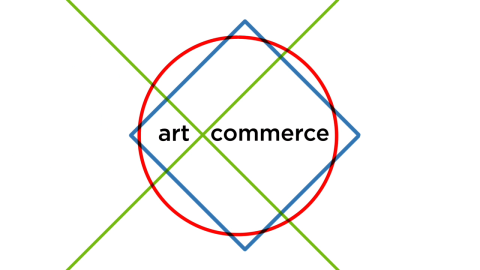Art + Commerce = The New Convergence That Defines Our World

How do ideas gain currency? They need to be expressed in the form of a story, one that will demonstrate how a product, cause or insight will actually impact people’s lives and the world around them.
That is why The Nantucket Project, an event held on Nantucket, MA from September 26 to 28, is dedicated to celebrating and recognizing the need for great storytelling.
While there is no secret sauce, the event provides a conceptual framework for its speakers (an acclaimed group of visionaries who represent a wide range of fields) to help the audience think through the creative and practical choices involved in bringing ideas into action.
The Nantucket Project calls this framework the convergence of art + commerce.
The Nantucket Project considers art broadly―as the creative drive that finds its expression in fields like poetry and graphic design, as well as in systems of thought such as theology. Correspondingly, think of commerce as the rational domain that includes scientific and mathematical considerations.
We invite you to play along with us.
“The theme of a conference could be the color blue,” jests Saul Wurman, the legendary founder of TED. “Every speaker could incorporate blue into their presentations and then everyone could congratulate themselves for being geniuses,” he says.
And yet, some names stick, and become part of a conversation with the greater culture. The name TED, after all, stands for technology, entertainment and design. Wurman observed that these three industries were converging into one thing when he founded the renowned conference back in 1984. Steve Jobs unveiled the Macintosh that year at TED. Jobs’s revolutionary product was the perfect illustration of the convergence of technology, entertainment and design, so Wurman really did look like a genius.
So conferences can indeed show us which way the world is heading. Wurman is now advising The Nantucket Project, and endorses art + commerce as “the new convergence” that defines our world today.
What’s the Big Idea?
Art and commerce are forces that can be traced throughout human history, and these forces often appear to be at odds with one another.
Today, however, we are seeing a powerful convergence between the two. In fact, The Nantucket Project views art + commerce as the convergence that defines human ingenuity in our world today, both in business and in the life of the mind.
So why is art + commerce suddenly all the rage?
The simple answer is the Internet. The landscape of commerce has changed. Every business and every individual today participates in a world of virtual commerce. This precipitates the need for great storytelling. The role of design and the arts is therefore greatly elevated in this environment.
“There has been a palpable recognition that businesses need the arts more than ever,” says Michael Spalter, the Chairman of the Board of the Rhode Island School of Design. “The challenge,” Spalter says, “is for businesses to figure out how to incorporate the creative fields into their ecosystems.”
To help facilitate this marriage of art and commerce, Spalter has launched the Creative Entrepreneurship Initiative at Harvard Business School, the first HBS initiative of its kind in decades.
Spalter sees creative entrepreneurship as an opportunity for people to create value with limited resources. This is an empowering idea for any entrepreneur, but it especially resonates in the developing world, where certain groups of people like women and girls are at risk like never before.
Spalter and the filmmaker, writer and artist Susan Dryfoos have contributed a white paper to the Harvard initiative in which they directly challenge common perceptions of creative people. On the one hand, there is the “old but still often repeated and believed image of the starving artist,” Spalter and Dryfoos note. However, “people can become successful (financially, mentally, emotionally, spiritually ― all the things that contribute to success) doing what they love to do,” the authors argue.
Along with Saul Wurman and an artfully curated group of thinkers in the creative and business fields, Spalter will be sharing his vision at The Nantucket Project.
Ideas Into Action
In a novel partnership, The Nantucket Project and Harbers Studios are inviting six members of the rising generation of filmmakers to attend the event, and then go on to produce short films inspired by ideas presented onstage. This represents a humble first step toward illuminating the most significant ideas in the world today, which is the goal of a larger collaboration The Nantucket Project is launching with Time.
The Nantucket Project’s founders see all of these efforts as part of a larger conversation that needs to take place in our culture. How do we ensure that the best ideas reach the surface?
“Content is the new data,” says Tom Scott, who founded The Nantucket Project with Kate Brosnan in 2011. Scott points out that Americans watch 50 billion videos online every month. “We’re bombarded from every direction. So learning how to tell your story well is a journey that every business and individual needs to take. We argue that in order to be effective in this environment you really need to achieve the right balance between art and commerce, and that’s what our event is about.”
*Speakers at The Nantucket Project this year represent a colorful blend of art and commerce that includes Randy Komisar, Partner at Kleiner Perkins Caufield & Byers, Ken Lerer, former Chairman and Co-Founder of The Huffington Post and Chairman of Betaworks and Buzzfeed, Danielle Fong, Founder of LightSail Energy, Walt Mossberg, founder of AllThingsD and Re/code, Larry Summers, the former Secretary of the Treasury, Shiza Shahid, Co-Founder of the Malala Fund, Scott Minerd, Chairman of Investments and Global Chief Investment Officer at Guggenheim Partners, Billy Collins, former U.S. Poet Laureate, David Rubenstein, Co-Founder and Partner at The Carlyle Group, Richard Haass, President of the Council on Foreign Relations, Julian Assange, who will be appearing in the form of a hologram, and many others.





